
views
- Stick with leather paint or spray paint if your shoes are made with vinyl or leather, or use fabric paint if you have cloth shoes.
- Lay some newspaper or craft paper down on your workspace and mask any parts of the shoe that you don't want to paint.
- Apply the paint to your shoe with a paintbrush or sponge, or spray it on directly.
- Add a layer of acrylic sealant to your shoes to protect your beautiful paint job.
Choosing Paint and a Design

Use leather or spray paint for leather or vinyl shoes. There are acrylic paints designed to adhere to leather products, including shoes. You can buy them at your local craft store or at Amazon, like these acrylic paints. These paints go on with a brush for a smooth and lasting finish. Your other option is to use spray paint purchased from a hardware store or online here. Choose a spray can with the smallest nozzle possible to minimize over-spraying. While spray painting your shoes is easy, it won’t allow you to get very detailed. Spraying works best when you are painting your entire shoes a single color. Remember to remove the shoe strings before you paint.
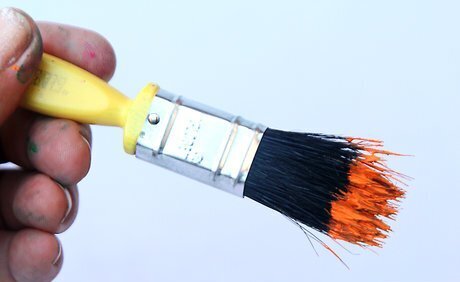
Use fabric paint for cloth shoes. This is a type of acrylic paint made specifically for fabric painting. It is applied with a brush and is quite durable. It also comes in a wide variety of colors, even with glitter options. Another plus is that it usually doesn’t crack after drying. You can also use fabric paint for leather or vinyl shoes. However, you have to extensively sand the surface of the shoe down almost to its fabric base or the paint will not adhere.
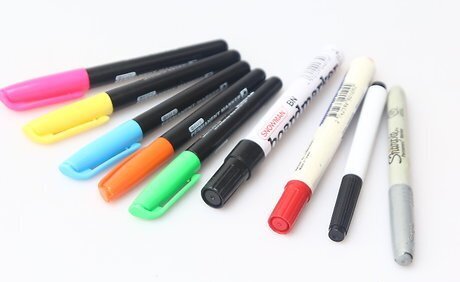
Use paint markers for detailed designs. You can buy paint markers at most art supply or craft stores, or online marketplaces like Amazon here. They come with a variety of tip sizes from super thick to ultra skinny. It’s usually a good idea to get a number of markers in the same colors, so that you can experiment. You’ll also want to test out the paint itself, as some are thicker in consistency.
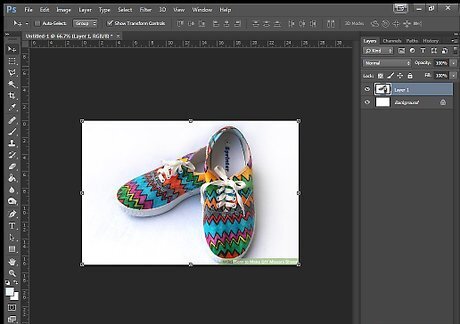
Create a design. If you plan to paint your shoes a single shade, then it’s as simple as choosing the color. If you are going to do a more elaborate pen drawing or painting, then go ahead and sketch out your ideas on paper in advance. You can also create a 3-D design with a computer program, such as Photoshop.
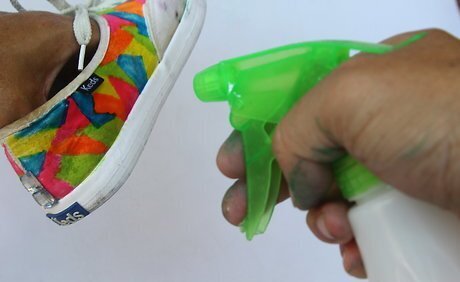
A fun way to make a tie-dye looking canvas shoe is to use permanent markers and rubbing alcohol. Draw on your design with the markers and use a cotton swab to dab at the colors. It will give them a softer look. Make sure to consider how your design will look from all angles, including the back and from an above view. If you are just starting out, try to avoid any designs that involve layering multiple colors or really intricate images. Instead, go with designs that feature large blocks of color, geometric images, or simple swirl patterns.
Preparing the Shoes
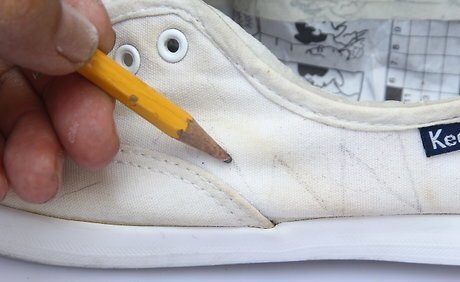
Outline your design in pencil on the shoe’s surface. If you keep your marks relatively light, then they won’t be noticeable even under the lightest of paint. Some people prefer to go over their pencil outline with a fine brush or fine tip marker as well. Before you finalize your drawing with marker, make sure that the design is symmetrical, if that is what you are going for. Check that the toes, heels, and sides are mirror images.

Cover your workspace with paper. Before you start painting, find a flat, steady table and cover it entirely with craft paper or newspaper. This will keep you from ruining your work surface in the event that you have a few paint drips or spills. You can also cut open brown paper grocery bags and secure them around the top and edges of the table. Be careful using newspaper if you are working with white or light fabric shoes. The newsprint can leave black smudges on the fabric.
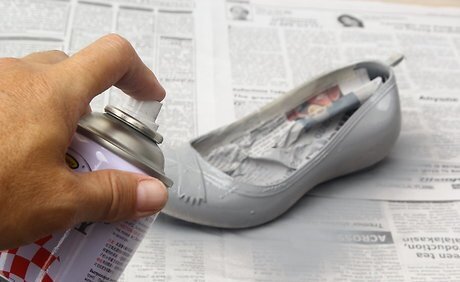
Practice painting on an old pair of shoes. This isn’t always an option, but if you have a cheap pair of shoes lying around then practice your technique on them. This gives you a chance to see if the paint is the right texture and color for what you want. You can even buy a pair of thrift store shoes to use as your practice pair.
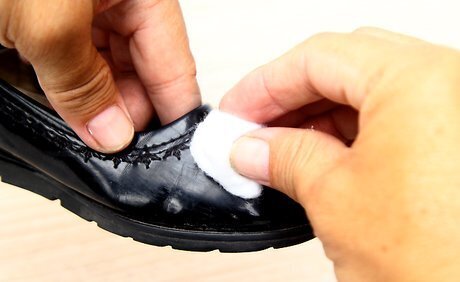
Clean the surface of the shoes. For natural leather shoes, soak a cotton ball in rubbing alcohol and gently rub this over the surface of the shoes. For manmade leather shoes, soak a cotton ball in acetone and wipe the shoes down. If you are painting cloth shoes that are a bit dirty, wipe them down with a rag soaked in warm water and soap. This should remove any debris from the surface of the shoe and help the paint to adhere. Let your shoes thoroughly dry after cleaning before attempting to paint. Make sure that you use 100% acetone for cleaning like this one, not a mixed nail polish remover.
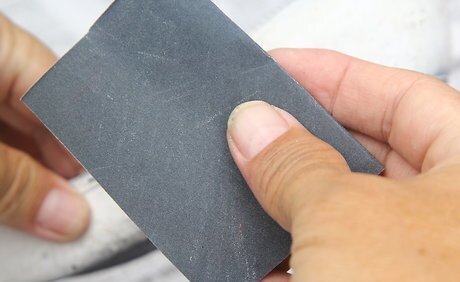
Sand away the finish if your shoes are shiny leather. Patent leather shoes are known for their shiny appearance, but it’s difficult for paint to stick to this surface. Get a fine grade sandpaper and rub over the surface of the shoe, moving in small circles. Continue until the shoe takes on a dull appearance. You can find sandpaper at a hardware store or online. Look over your shoes and make sure that your sanding is even from all angles. Otherwise, you may get an uneven appearance after painting.
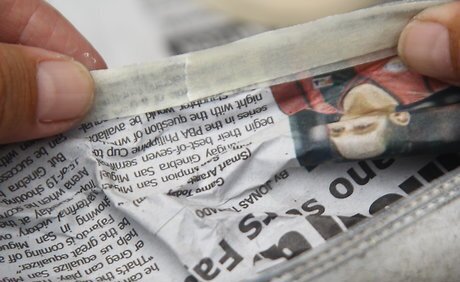
Cover the inside and sole with tape. Apply thin strips of painters’ tape to all of the shoe’s surfaces that you don’t want to paint. This means you’ll need to go around the soles of the shoes as well. Some people also stuff newspaper into the inside of the shoes to help them keep their shape while wet. Painters tape will make sure the paint doesn't get anywhere it's not wanted. You can find it in hardware stores or online.
Applying the Paint
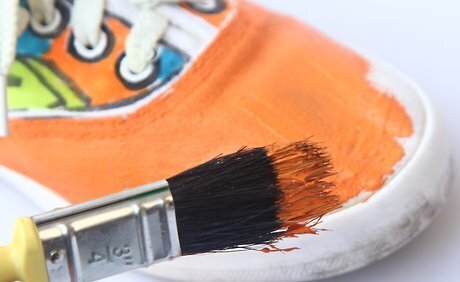
Apply fabric or leather paint with even, short brush strokes. If you are using acrylic paints, dip your brush into the paint and then put the paint on the shoes using short strokes. Keep refilling your brush until you’ve fully coated the area and no longer see any of the shoe’s original surface. A #6 or #8 brush is flatter and good for painting the edges areas. A #0 or #1 round brush has a fine shape that works well for details. A #1 or #2 fan brush can spread paint over the flat sides of a shoe quickly. You can find variety packs of paintbrushes on Amazon here.

Apply fabric or leather paint with a sponge for a partially covered look. Get a small bath or scrub sponge. Pour your paint into a small bowl. Dip the edge of the sponge into the bowl. Then, dab the extra paint off on a nearby piece of paper. After that you can start to quickly press the painted sponge against the shoe until it is painted. This is a great approach if you’d like to layer colors or even have the original color of the shoes partially show through.

Spray paint onto the shoes if you want a single color. Hold your spray can nozzle about 4-6” away from the shoes. Press firmly against the nozzle trigger to apply an even coating of paint across the entire shoe. Make sure that you cover all areas.
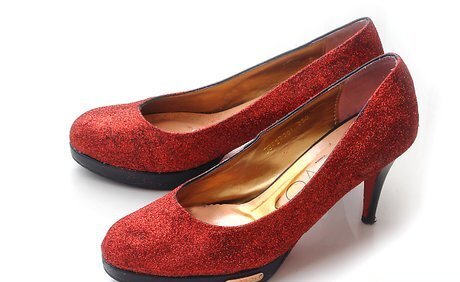
Coat the shoes with a glitter mixture. Get a plastic cup and pour 1/2 cup (4 ounces) of Mod Podge into it. Add a small container of glitter and stir it together. Use a paint brush to apply the glitter mixture on top of your current shoe’s fabric. You can also use this over newly painted shoes, but they’ll need to be fully dry first.
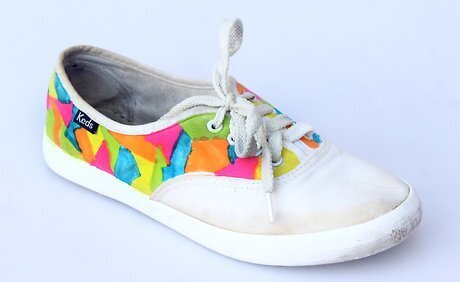
Let the shoes dry. Leave the shoes on the paper-covered table for at least 1 hour or until they are fully dry. Then, you can apply a second coat of paint, if needed. You’ll also want to wait 2-3 days to wear them. This allows your shoes to dry on both the outside and inside (if any paint seeped through). To keep your brushes and sponges from drying out in between coats, place them in some plastic wrap.
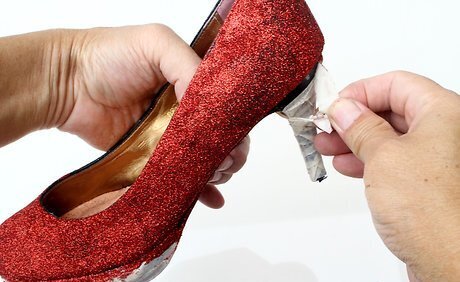
Peel off the protective tape slowly. Grab the ends of each piece of tape and apply gentle pressure until it pulls away from the shoe. Continue until you’ve removed all of the pieces. If you see any small pieces remaining, use metal tweezers to carefully remove them.

Apply a spray on acrylic sealer and avoid washing your shoes. If you are worried about your design getting damaged by water, you can spray your finished shoes with an acrylic sealer spray (for cloth shoes) or even a clear matte spray paint (for leather shoes). This will protect your shoes from exposure to the rain, but it is still not a good idea to wash your shoes in a machine. If they get dirty, simply dab at the spot with a warm wash cloth.



















Comments
0 comment